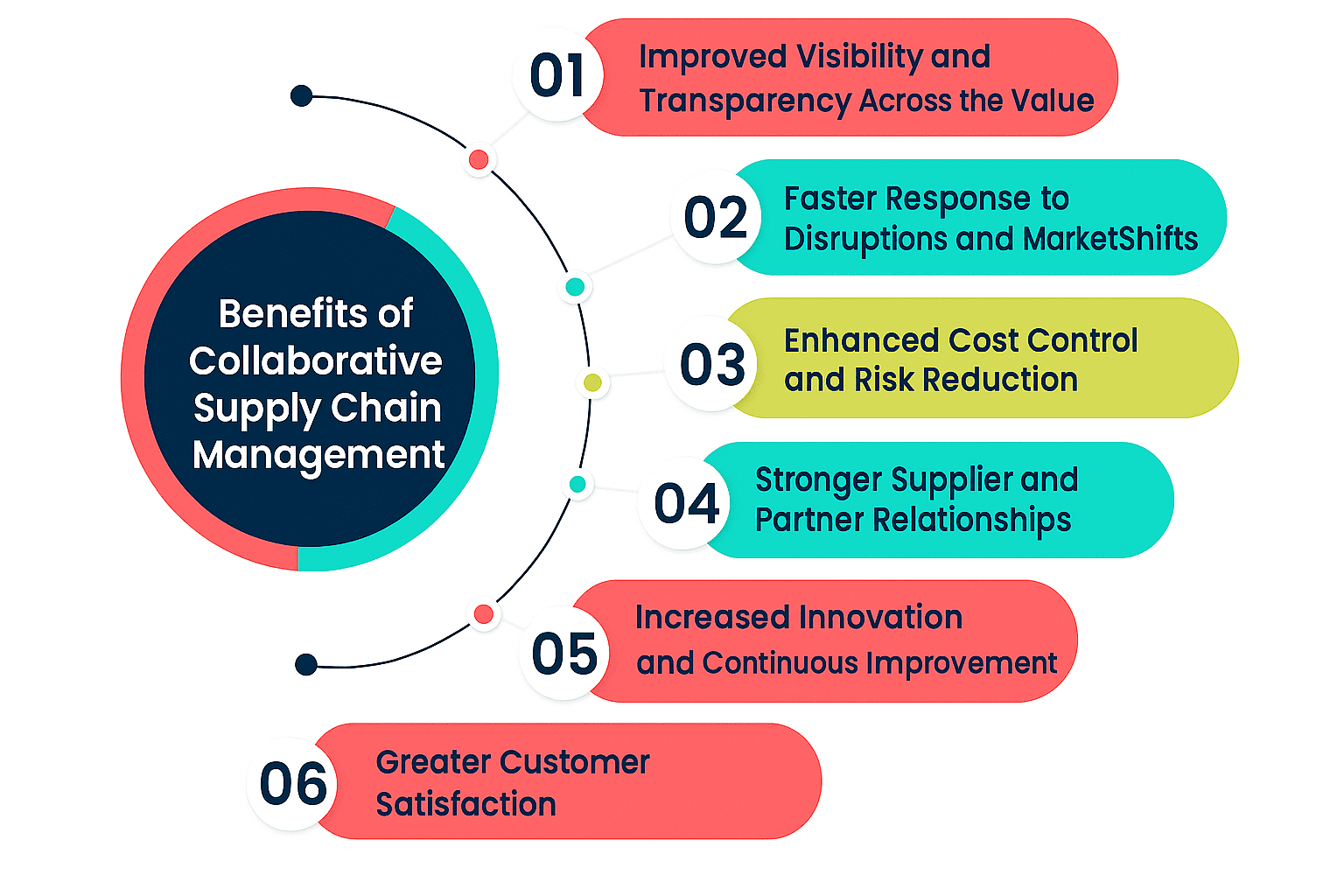Supply chain volatility and operational risks are rising across industrial sectors. To remain competitive and resilient, organizations can no longer rely on isolated, transactional supplier relationships. Collaborative supply chain management enables you to enhance visibility, respond more quickly to disruptions, and create measurable value with your partners.
According to a McKinsey survey, companies with strong supply chain collaboration achieved approximately 2 times revenue growth and 4.9% higher Earnings Before Interest and Taxes (EBIT) compared to competitors lacking such integration.
This article defines collaborative supply chain management, outlines its strategic advantages, and provides a structured approach for implementation in an enterprise environment.
What Is Collaborative Supply Chain Management?

Collaborative supply chain management is an integrated framework in which organizations and their key suppliers, partners, and logistics providers coordinate processes, share real-time information, and make joint decisions to achieve shared business objectives.
In contrast to conventional supply chain management, which often focuses on independent execution and short-term cost optimization, collaborative models emphasize end-to-end visibility, risk sharing, and synchronized planning. Partners move beyond individual interests to pursue collective outcomes, enhancing operational agility and value creation across the network.
Core components of collaborative supply chain management include:
- Information sharing: Timely exchange of inventory levels, demand signals, production plans, and disruptions across the value chain.
- Aligned goals: Agreement on key performance indicators, service levels, and business priorities that reflect mutual interests.
- Integrated planning: Coordinated forecasting, replenishment, and logistics activities that optimize resources and minimize inefficiencies.
- Joint decision-making: Structured processes for resolving challenges, allocating resources, and capitalizing on new opportunities together.
Benefits of Collaborative Supply Chain Management

Collaborative supply chain management delivers tangible advantages across operational, financial, and strategic dimensions.
1. Improved Visibility and Transparency Across the Value Chain
Real-time data sharing and integrated processes provide full visibility into inventory, demand, and production status. This transparency enables better decision-making and supports proactive management of risks and opportunities.
2. Faster Response to Disruptions and Market Shifts
Collaborative networks allow partners to share early warnings and coordinate responses to unexpected events. This agility reduces downtime, minimizes disruption costs, and helps maintain service continuity.
3. Enhanced Cost Control and Risk Reduction
Joint planning and shared information eliminate redundant activities, reduce excess inventory, and identify new savings opportunities. By distributing risk across the supply network, organizations gain greater agility to address supply disruptions, quality concerns, and compliance challenges as they arise.
4. Stronger Supplier and Partner Relationships
Collaboration fosters long-term, trust-based supply chain partnerships that go beyond transactional interactions. These relationships foster shared growth, promote open communication, and lead to more reliable performance across the network.
5. Increased Innovation and Continuous Improvement
Partners engaged in collaborative processes are more likely to share ideas, co-develop solutions, and implement process improvements. This environment accelerates innovation and drives ongoing performance gains.
6. Greater Customer Satisfaction
Consistent alignment across the supply chain results in better product availability, on-time delivery, and higher service quality. Organizations that collaborate effectively are better equipped to meet customer expectations and sustain loyalty in a competitive market.
How to Implement Collaborative Supply Chain Management in Your Organization

Implementing collaborative supply chain management requires a disciplined, step-by-step approach that aligns people, processes, and technology across your network.
Step 1: Assess Your Current Supply Chain Maturity and Readiness
Start with a thorough evaluation of your existing supply chain processes, digital capabilities, and organizational culture. Map your end-to-end workflows, identify where information silos or manual interventions slow performance, and assess your current level of supply chain visibility.
Use maturity models or benchmarking tools to compare your practices against industry standards. This assessment establishes a baseline and highlights key gaps that need to be addressed before collaboration can succeed. It is a critical first step in building supply chain resilience.
Step 2: Identify Key Partners and Align on Mutual Goals
Prioritize suppliers, logistics providers, and partners that are critical to your business objectives and willing to engage in a collaborative approach. Initiate open discussions to understand their strategic priorities, operational constraints, and desired outcomes. Co-develop a set of shared goals—such as improved service levels, cost reduction, supply resilience, or sustainability targets—that support mutual value and create a foundation of trust.
Step 3: Invest in Enabling Technology
Deploy digital platforms that facilitate real-time data exchange, process integration, and performance monitoring. Cloud-based supply chain management solutions, real-time analytics, and IoT-enabled visibility tools allow all parties to access up-to-date information on inventory, demand, and shipments. Select technologies that are interoperable with your partners’ systems and scalable to support evolving business needs.
Step 4: Establish Clear Communication Channels and Data-Sharing Protocols
Formalize communication structures by setting up secure, standardized channels for information exchange. Define the types of data to be shared, the frequency of updates, and the protocols for maintaining data accuracy and confidentiality.
Ensure that all stakeholders understand how and when to communicate so that issues are addressed promptly and information flows seamlessly across the supply chain.
Step 5: Define Joint KPIs, Incentives, and Accountability Measures
Collaboratively determine key performance indicators that align with both your organization’s and your partners’ objectives. Establish clear metrics for service levels, on-time delivery, inventory turnover, and cost savings.
Develop incentive programs—such as gainsharing or performance bonuses—that reward collaborative behavior. Assign accountability for each metric to ensure ongoing focus and transparent performance tracking.
Step 6: Develop Governance Structures for Collaboration
Implement governance frameworks that outline roles, responsibilities, and decision-making authority for all involved parties. Set up escalation paths and conflict resolution procedures to address disagreements or operational challenges quickly. Schedule regular review meetings to evaluate progress, resolve issues, and make joint decisions as the collaboration evolves.
Step 7: Launch Pilot Projects and Measure Results
Begin with targeted pilot initiatives involving a small set of processes or supply chain partners. Set clear objectives and success criteria, monitor performance in real time, and gather both quantitative data and qualitative feedback. Use pilots to test new ways of working, identify barriers, and demonstrate the tangible benefits of collaboration before expanding further.
Step 8: Scale Collaboration Based on Early Wins and Lessons Learned
Analyze the results of your pilot projects to identify what worked well and what needs adjustment. Use documented successes and lessons learned to refine your approach and build organizational buy-in. Gradually expand collaborative practices to additional partners, business units, or geographies, ensuring that structures and processes remain scalable and adaptable as your network grows.
Final Thoughts
Collaborative Supply Chain Management helps you achieve greater efficiency, reduce costs, and strengthen your operational resilience. By sharing real-time data, aligning goals with suppliers and partners, and proactively managing risks, your organization achieves measurable improvements in inventory management, responsiveness, and customer satisfaction.
Collaboration isn’t optional—it's critical. The industrial and manufacturing landscape is evolving quickly, and isolated efforts can no longer keep pace. Embracing collaboration ensures your supply chain remains agile, competitive, and strategically aligned.






